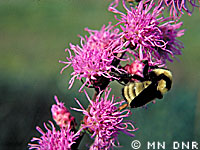Native Plant Events
There are 3 opportunities to learn about and interact with native plants in the next week. Please consider attending one of these free events!
This weekend Joel Dunnette will be leading two public seed collecting sessions. No prior experience is needed. Necessary equipment will be provided, but you should dress for uneven ground and tall vegetation, and for being in the sun and wind. You might want to bring water.
Saturday, 9/17
Weaver Dunes (A Nature Conservancy Preserve) Native Seed Collecting
Meet at 10am at the office/maintenance buildings. Bring lunch. This large preserve has unusual sand prairie plants, and rolling dunes. Seed will be used to plant / diversify former crop fields that have been acquired and added to the preserve. We usually work for a couple hours, break for lunch, then work another hour or two. Be prepared for walking through poison ivy and some scratchy plants.
Directions
from the south
– get to the intersection of US 61 and MN 74 in Weaver MN
– go north on US 61 for 1.7 miles
– turn right (east) onto Wabasha county 84
– go about 1.8 miles
– watch for the sign for the preserve at the end of a driveway
– drive in and park near the house and pole building
from the north
– come down US 61 to Kellogg;
– continue south on 61 for 5.6 miles
– turn left (east) onto Wabasha county 84
– go about 1.8 miles
– watch for the sign for the preserve at the end of a driveway
– drive in and park near the house and pole building
2. Sunday, 9/18
Olmsted County’s Chester Woods park; on US 14 east of Rochester and west of Eyota
Meet at 1:30pm at the park office and maintenance building area – once you enter the park and pass the contact station, take the first right. We will be driving to another area of the park. This session will not involve as much hiking, so might be OK for children, as long as they can tolerate tall vegetation. We will work for 2-4 hours, and you can drop out any time. The seed will be used for enhancing plantings on Olmsted county properties. This is also the September event of the Rochester chapter of MN Master Naturalist volunteers.
Note that a session will NOT be held if the vegetation is damp. Call Joel Dunnette at 507-269-7064 if you have questions on the day of the event.
Also, if you have prairie plantings near you, and would like to enhance them, you are invited to come pick seed at my own property, where the planting is mature, diverse, and very accessible. Since species mature at different times, any one day will yield less than the full diversity we have to offer. So, at the end of the season, we will share the seed we pick and divide it up based on amount worked and project quality. If you are interested, let me know so that we can arrange a time that is mutually acceptable.
3. Monday, 9/19
Cascade Meadow Wetlands & Environmental Science Center Native Plant Workshop Hear from local experts about the benefits of native plants, how to identify them, how to maintain native areas, and take a tour of our native plantings where you will be able to collect and take home a nice variety of seeds. RSVP to aplute@rochestermn.gov or call 328-2440. FREE.
So, why would you want to pick seed of prairie plants?
– the fall weather can be beautiful
– you will learn about a lot of plants
– the textures and smells can be quite interesting
– it can be a highly social activity; chatting while you pick does not slow you down (much)
– you might see some places you have never been, but might enjoy
– it gets you outdoors in nature, which helps your mental well-being (according to research)
– you can get MNat credit for volunteer work
– the seed will be used to enhance diversity of plantings, so they:
– have bloom over a longer season
– provide food for a wider range of insects, birds, and mammals
– help sequester carbon better (than non-native, short-lived, short-rooted plants)
– have a better ability to withstand changes in conditions
– have more diverse attractions for the public
– you can see result from planting prairie seed within a few years; much less than from planting a tree!
Have a comment? Join us on Facebook!
